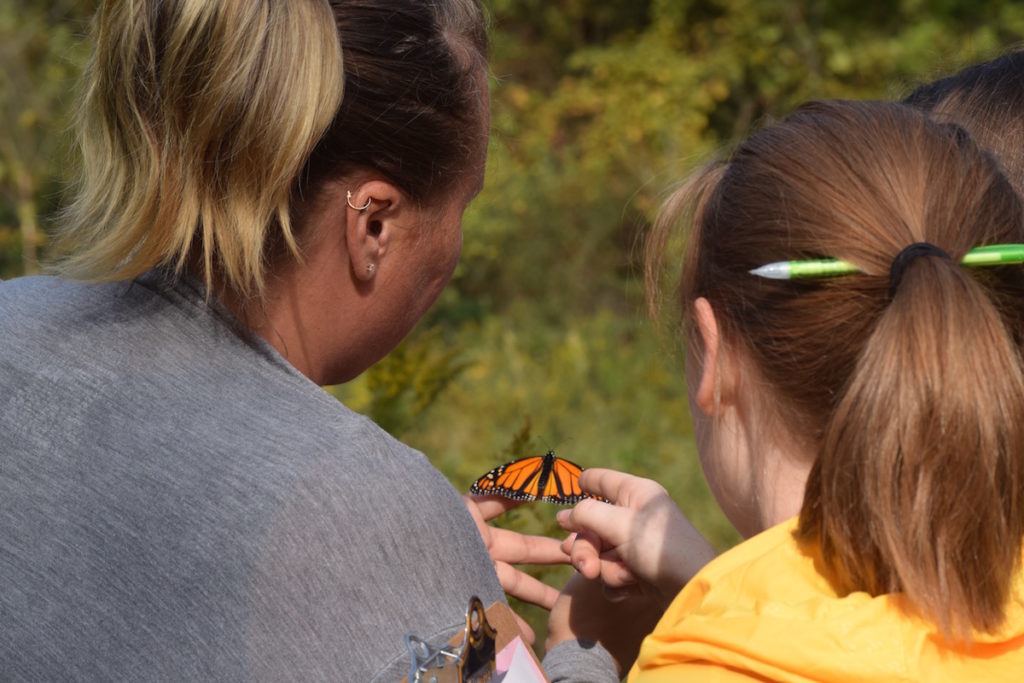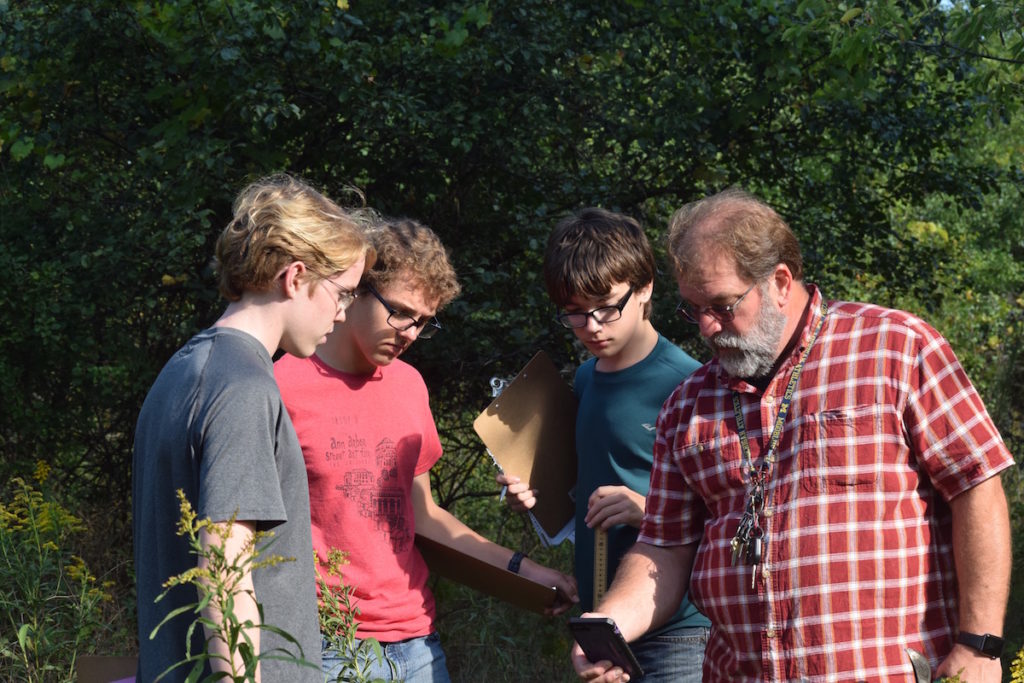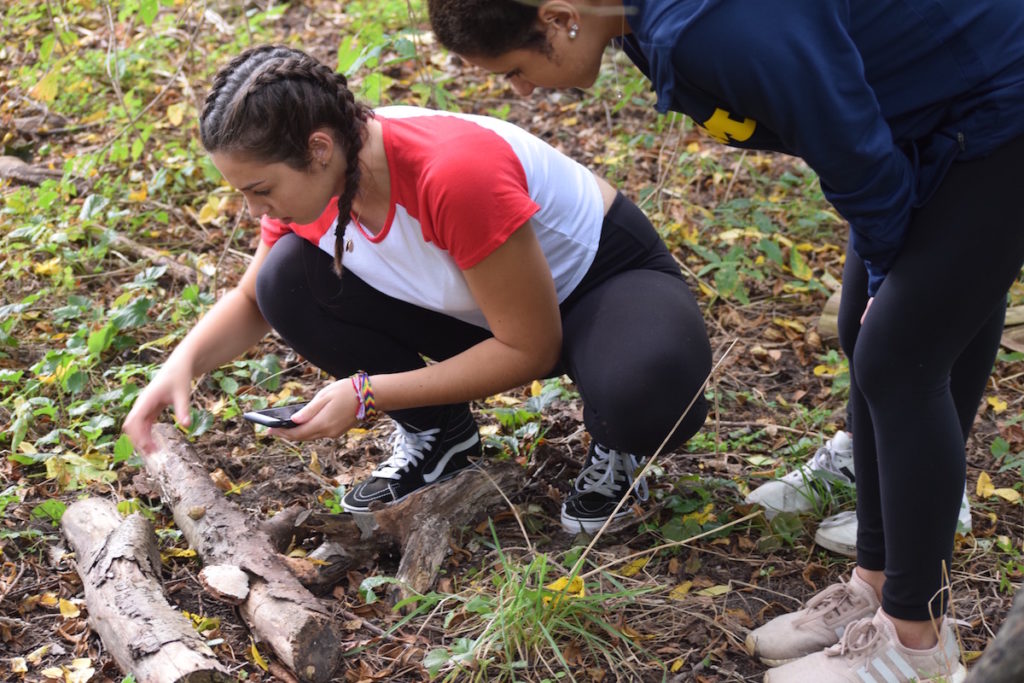Story, photos, and video by Andrew Cluley/AAPS Director of Communications
This summer the Ann Arbor Public Schools regained control of the Freeman School property northeast of Ann Arbor as the Board of Education opted not to continue leasing the site. The decision was made so the district could create an environmental education center. Recently, students from Pioneer and Skyline became the first AAPS students to get hands on environmental education experience at Freeman School.
A visitor to the school might have been perplexed seeing the AP Environmental Science students staring at their cell-phones in the property’s woods. While at first glance this might seem like a concerning focus on technology over nature, in reality these students were both getting a real world educational experience and providing a valuable service for AAPS. They were examining the biodiversity in the approximately 20 acres of wooded land at the Freeman property.
 Within areas roughly 20 feet square, students identified species of plants, bugs, and animals present, mapped areas studied, and even used species counts in square meter quadrants to calculate how their area’s Simpson’s Diversity Index score. This data may prove very useful as an advisory committee continues work on imagining what AAPS can do with the Freeman site in terms of creating an environmental education center.
Within areas roughly 20 feet square, students identified species of plants, bugs, and animals present, mapped areas studied, and even used species counts in square meter quadrants to calculate how their area’s Simpson’s Diversity Index score. This data may prove very useful as an advisory committee continues work on imagining what AAPS can do with the Freeman site in terms of creating an environmental education center.
Skyline’s Gabriella Mack enjoyed getting the opportunity to get out of the classroom and not just read about science in a textbook. Mack says her group was also surprised at the amount of biodiversity they found in a section of the property that initially appeared to be overwhelmed with only one type of plant. “We thought it was just going to be a lot of golden rod because when we first came here that’s all we could see is just golden rod,” says Mack. “We didn’t think that we would find all of these species”
It wasn’t just the students surprised with the amount of biodiversity. Environmental Education Consultant Dave Szczygiel was amazed at what the students found as well. This includes wild cucumber, a brown decayed snake, the biggest tree frog Szczygiel has ever seen, and lots of plants he hadn’t considered growing here. For Szczygiel this is the perfect type of project for the students. “I love projects like that, where the community cares about what’s happening and the kids are taking real data and they’re going to go back and give us some information about something that everybody wants to know about, so it’s perfect education in real time.”
Skyline science teacher Casey Warner says the students got to practice a bit on some of the land around Skyline but classes the last few years have studied those locations so the data is already largely known. Warner says the chance to collect raw data is cool, and some of the students that had taken the class last year were disappointed they didn’t get this opportunity.
 While a couple of volunteer naturalists were on the site to help, Warner says students were able to use technology as well in trying to determine what they were finding. “They have these really neat free apps now like iNaturalist and PictureThis – Plant Identification,” Warner says. “So the kids can download it right on their phone and take a picture and it comes up with maybe the top five possible species right away, and then they can read through the descriptions and figure out what it is.”
While a couple of volunteer naturalists were on the site to help, Warner says students were able to use technology as well in trying to determine what they were finding. “They have these really neat free apps now like iNaturalist and PictureThis – Plant Identification,” Warner says. “So the kids can download it right on their phone and take a picture and it comes up with maybe the top five possible species right away, and then they can read through the descriptions and figure out what it is.”
The students mapped their sites by hand, a skill Warner says is important for them to learn, but she eventually hopes to have students do GPS mapping. “As we’re working on the Freeman site and getting a nature center here, how cool would it be if these kids could be in charge of mapping some of the neat stuff that’s around here,” Warner says. “Having something that visitors could actually use to look at that’s like this inter-active map.”
School Board President Christine Stead says the board is so excited about the enhancements that are possible in our environmental education program across the district that the Freeman property will enable. She describes the students as pioneers as they map out the ecosystem in the area. “This program is the culmination of our collective interests in enhancing the education we provide in the AAPS on the environment and is led by our wonderful Environmental Education Consultant, Dave Szcyzgiel,” Stead says. “We look forward to how this program will develop for all students at all levels across the AAPS. In Ann Arbor, we know how important preserving our environment is and we are proud to be able to enhance all students’ first-hand understanding in this important area.”
The Board of Education is holding their study session at the Freeman site on Wednesday following a ribbon cutting ceremony celebrating the future educational center. Some of the Skyline students will share their reports on the biodiversity they found.

What a wonderful opportunity! Minor correction: I believe that should be brown (Dekay’s) snake (Storeria dekayi) – not a decayed snake.